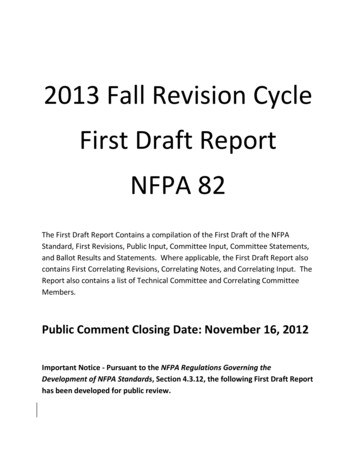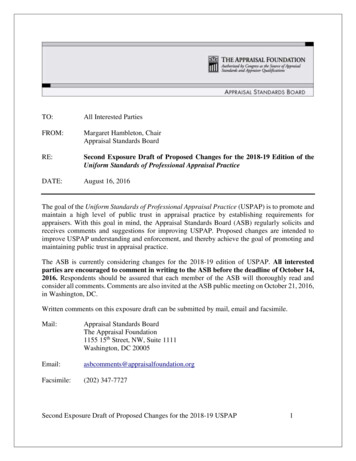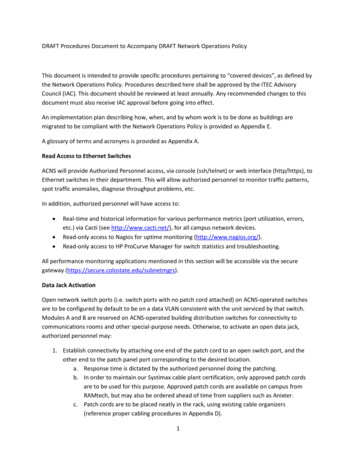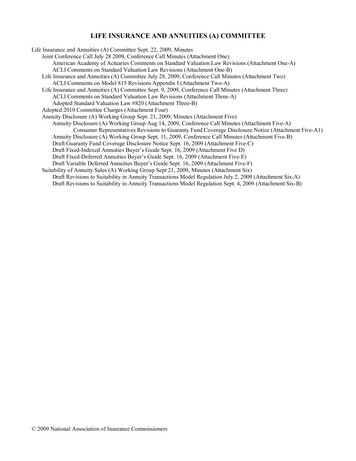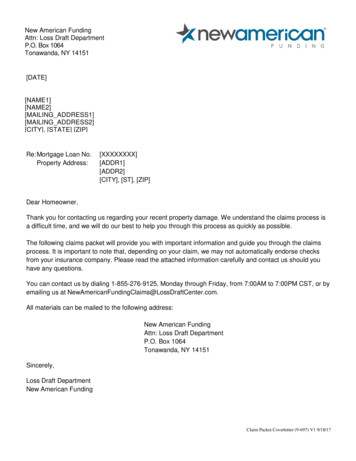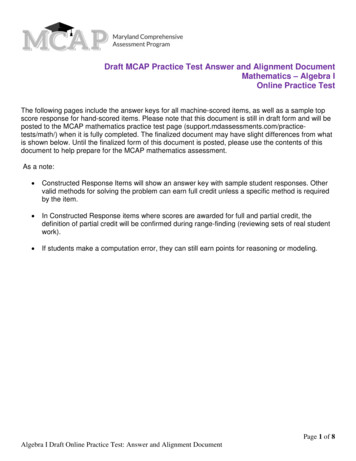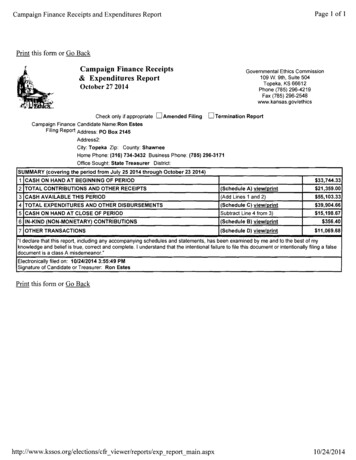
Transcription
Chair’s MessageWelcome to this 8th edition of The Morpheus Reporter! The major thrust of the university’s department activities for the lastseveral months has been honing the departmental strategic plan. I would like to take this opportunity to update all of ourmembers on the state of play. The strategic planning for the Department is currently being discussed at each of the hospitaldepartments by the chair and the hospital’s Anesthesiologist‐in‐Chief. This is the finalprocess following a careful series of consultations among the executive, faculty, allmembers of the department and a presentation in December of last year to theDean’s executive in the Faulty of Medicine. The department’s vision and missionstatements are in many ways the driver for the strategic plan. The departmentalNew Appointments:vision is: “The prevision of safe and innovative anesthesia as a perioperative andDr. Sal Spadafora .2critical care medicine”; the mission statement is: “The delivery and promotion ofDr. Martin van der Vyver .2preeminent peri‐operative care through continued vigilance, innovation andNew Faculty Members .3scholarship”. Both the vision and mission statements are entirely consistent andemphasize the importance of imagination, rigor and intellect in developing newNew Faculty Hires, Promotions andknowledge (research), imparting that knowledge to all members of the anesthesiaAcademic Rank 3care team (education), and advocating in all areas for the benefits of our patients.In Memory: Dr. John Desmond .4The strategic plan follows closely with the Faculty of Medicine’s articulated values2010‐2011: UG Double Cohort gic.htm) and our plan focuses on:In this Edition .1. Advancement;2. Productivity measurement and accountability;3. Facilitating educators so that we have the best possible teaching;4. Facilitating learners so that we recruit and educate the best trainees at theresident, fellow and graduate student level;5. Research ‐‐ so that we can develop new knowledge;6. Development of a vigorous alumnus program;7. A strategic for advocacy, leadership, and communication of why anesthesia mattersand why it is important to continually improve scientific base and its dissemination.After discussion with all of the hospital departments the plan will go to print andmuch of the hard work involved in its development will be continued in implementingit. This will require ongoing effort on the part of all department members andpromises to be a very fulfilling phase in the life of the departments of anesthesia atthe university and hospitals.Thank you for your participation in this process!Featured Investigator: Dr. BrianCuthbertson .5CAS‐IEF Rwanda Residency TrainingPartnership .7OMA Section on AnesthesiologyReferendum Results .10CPSO: Bill 179 and OHPIP .112010 Olympics: Science Coverage .12CME Courses and Events .13Book Review: Ultrasound‐GuidedAnesthesia (Pollard & Chan) .14Recent Publications .14
Dr. Salvatore Spadafora, Vice Dean, Post Graduate Medical EducationAssociate Professor, UT Department of AnesthesiaI am delighted to announce that our Academic Board has approved the appointment of Dr. Salvatore (Sal)Spadafora as Vice Dean, Post Graduate Medical Education, for a five year term commencing January 1,2010. The month of January will be a transition period for Dr. Spadafora into his new role. He currentlyserves as Associate Dean, Postgraduate Medical Education at the Schulich School of Medicine andDentistry at the University of Western Ontario, and is an Anesthesiologist at the London Health SciencesCentre and St. Joseph's Health Centre in London.A graduate of the University of Toronto, Faculty of Medicine, Dr. Spadafora has distinguished himself as aleader in medical education. He also completed his Masters in Health Professions Education at theUniversity of Illinois Department of Medical Education. He has served as the Program Director for the University of WesternOntario's (UWO) Anesthesia and Family Medicine Anesthesia residency programs; and, nationally as a member of importantleadership committees of the Canadian Anesthesiologists' Society and the Royal College of Physicians and Surgeons of Canada. Dr.Spadafora has advocated effectively and tirelessly for medical education to benefit Canadian patients and patient populationswith respect to fiscal and human resources, education methodology and technology, and the social mission of medical educationincluding developing strategies to integrate education among urban and small community sites. He has developed models of inter‐professional education and assessment and integration of international medical graduates provincially. Dr. Spadafora is therecipient of numerous prestigious education awards, recognized by national organizations, his peers and, most importantly, hisstudents and trainees. He is highly respected by health care educators and scholars nationally for his high scholarly and ethicalstandards, exceptional capacity for work, and consensus building and common sense approaches to solving difficult problems.Please join me in warmly welcoming Dr. Spadafora to his new role at the Faculty of Medicine, University of Toronto.Catharine Whiteside, Dean, Faculty of MedicineVice Provost, Relations with Health Care InstitutionsNew: Director, Faculty Development ‐ Dr. Martin van der VyverSubmitted by: Dr. Brian KavanaghI am very pleased do announce the appointment of Dr. Martin van der Vyver to the position of Director,Faculty Development, UT Department of Anesthesia for a two‐year term commencing in July. In this newposition, Dr. van der Vyver will be responsible for organizing and implementing various initiatives related tothe department’s new strategic plan (platform 3: Facilitating Educators) including organization andimplementation of the Annual Faculty Development Day event; development and implementation of acomprehensive first‐year experience program for new faculty members; and faculty development (e.g.,faculty development/teaching remediation; needs assessments, awards database, and communications).Dr. van der Vyver is a staff anesthesiologist at the Sunnybrook Health Sciences Centre. He completed his medical degree at theUniversity of Stellenbosch in South Africa in 1988, and after working in several community hospitals, he returned to the academichospital setting, completing of his residency in Anesthesia in 1999. He followed this with a fellowship in obstetric anesthesia atWomen’s College Hospital, and after a short return to Cape Town for 2 years he took up a position as a staff anesthetist atWomen’s College Hospital in 2003. He passed the Royal College of Physicians and Surgeons of Canada exam in Anesthesia in 2005,and completed the Education Scholars Program (an advanced faculty development program offered by the Centre for FacultyDevelopment, University of Toronto) in 2008. He has filled educationalMARK YOUR CALENDARS!roles in undergraduate and continuing education, and is currently the chairof the Continuing Professional Development committee of the CanadianThe Annual Shields Research Day 2010 willAnesthesiology Society.take place on Friday, May 7, 2010 at the BahenCentre, University of Toronto.Together with Dr. Peter Slinger, Dr. van der Vyver planned and organized avery successful Faculty Development Day in November 2009. The (trulyThe Annual Faculty Development Day 2010outstanding) evaluations for this event can be found on our internalwill take place on November 11, 2010 at the 89website [“Staff Login”, “Events”, “Evaluations”]. Please join us in welcomingChestnut Residence and Conference Centre,Dr. van der Vyver to this new position.University of Toronto.UT Department of Anesthesia – The Morpheus Reporter – Issue 8, February 2010 / 2
New Faculty HiresPlease join us in welcoming the following new faculty members to the University of Toronto, Department of Anesthesia:Full‐Time Faculty: Dr. Brian Cuthbertson, Professor, Sunnybrook Health Sciences Centre (see Featured Researcher profile on page 5) Dr. Salvatore Spadafora, Associate Professor, UHN‐Mount Sinai Hospital (see announcement ‐ above) Dr. Sheila Riazi, Assistant Professor, UHN‐Toronto Western HospitalPart‐Time Faculty: Dr. Felix Bassoon, Lecturer, Humber River Regional Hospital Dr. Steven Bernstein, Lecturer, Humber River Regional Hospital Dr. Michael Friedland, Lecturer, Trillium Health Centre Dr. Sujata Sikka, Lecturer, Trillium Health CentreNew Faculty Hires, Promotions and Academic RankRecently, important questions were posed about how the academic rank of new faculty members is determined, as well as aboutthe process of promotion from the rank of Lecturer to Assistant Professor. These issues were addressed in a letter by Dr. DavidMcKnight, Chair of the Departmental Appointments Committee, to Dr. Kavanagh. A copy of this letter can be found on thedepartment’s internal website under “Promotions”. The following (italics) is an excerpt from Dr. McKnight’s letter:The DAC uses the Guidelines of the Faculty of Medicine Faculty Appointments Advisory Committee (FAAC) as set out in Appendix 1and 2 of its June 2007 document. http://www.facmed.utoronto.ca/Assets/HR/Terms of Reference !5b2 !5d.doc?method 1Initial AppointmentsAppendix 1 Guidelines Used for Initial Appointment as Assistant Professor rankThis rank is appropriate IF the faculty member has completed a recognized graduate program (or an advanced training experiencedeemed to be equivalent to a Master’s level program. ” ). This guideline has been used by the DAC to recommend initialappointment as assistant professors if the candidate has completed a Master’s degree.Promotion“Appendix 2 Guidelines for Promotion from Lecturer to Assistant ProfessorThere are two circumstances that may be applied.1) Advanced Degree: If the faculty member who holds a lecturer appointment, completes a recognized graduate program, Or2) Sustained commitment to academic mission: If a faculty member demonstrates a sustained commitment to teaching, researchand/or creative professional activity over a period of time as a Lecturer, he/she may be considered for appointment at theAssistant Professor rank. ” The DAC uses this guideline and also keeps in mind the current working rule of the FAAC that thosefaculty members promoted to Assistant Professor ought to have at least one peer‐reviewed publication. (Personal communicationfrom Dr John Bohnen, Vice Dean, Clinical Affairs.) The DAC has interpreted this to mean a relevant paper published during trainingor practice. We have not considered as relevant papers published prior to the individual’s enrolment in a residency program.This then leaves the DAC to deliberate on what constitutes “sustained commitment to academic mission.” Each application isconsidered on its own merits. There is no faculty guideline on how long “sustained” ought to be, and the DAC has not establishedone either. In reaching our decisions, when a faculty member is applying after just a few years ( 5), the DAC has looked forevidence of new program development or educational innovation. Even those who have been faculty longer than five years willneed significant accomplishments to convince the FAAC to waive its one‐paper rule.Members of the Department of Anesthesia may find that this procedure is a departure from the past when promotion fromLecturer to Assistant Professor was almost automatic. This is indeed the case. There has been a decision on the part of the Facultyto demand more of such promotions.Finally, it is important to point out that although the DAC does its best to make fair decisions, there may be times when it missessomething or errs in other ways. As for all committees and panels in the Faculty of Medicine, decisions of the DAC are appealable;in this case I believe appeals would be through the Chair.UT Department of Anesthesia – The Morpheus Reporter – Issue 8, February 2010 / 3
In Memory of Dr. John ‘Desi’ DesmondSubmitted by: Dr. Gerald O’LearyDr. John ‘Desi’ Desmond passed away on December 11, 2009 at UHN. Desi was on staff at TGH for decades.Not only was he a really good anesthesiologist but he was a lot of fun to be around. I think this is one of thereasons why he was such an exceptional teacher beloved by clerks, residents and staff, quite simply he madelearning fun. He was the recipient of numerous teaching awards and has an award named after himpresented annually at Shields Day. Desi was also a clinical scientist with a string of publications from 1956‐1986 that effected change in clinical practice. I was fortunate to work with Desi from 1987 onwards. Iremember him as a really nice man who cared for the welfare of his patients, his students and his colleagues.Perhaps this is best illustrated by some of Desi’s 29 “Commandments of Anesthesia”:1. The golden rule of anesthesia ‐ be kind and considerate.2. Endotracheal intubation at induction—when in doubt take it out, at the end of the procedure—when in doubt leave it in.6. You can always give more medication but you can’t take it back. 8. Always check your machine before drawing up your drugs.14. If it is worth doing, do it well.15. Before you start, make sure that you have a full vaporizer and an empty bladder.29. A new breed of anesthetists are now being trained. You will be the one who sets the standards for the 21st Century. Look backover the past century and see how much we have progressed. It’s been because “some men squandered their lives for a goodcause”. Do the same with your life.His life was not squandered. We have all benefited enormously from it. Thank you old friend. Sleep well.UT Anesthesia Teaching and Research AwardsSubmitted by: Dr. Brian KavanaghUntil last year, the UT Anesthesia teaching and research awards were typically presented at the Annual Shields Research Day. Withthe implementation of the Annual Faculty Development Day in November 2009 (a key component in the department’s overallstrategic plan), and following the Faculty Recognition Event on October 30, 2009, it was decided that the awards would bepresented as follows in 2010 and beyond: Research‐related Awards will be presented at the Annual Shields Research Day in May of each year; and, Teaching Awards (e.g., Desmond, Edelist, Fear awards) will be presented at the Annual Faculty Development Day event inNovember of each year. This event is now the premiere teaching‐related meeting for all of our faculty and fellows.Announcements with the relevant application submission dates will continue to be circulated widely via email, and posted on theUT Anesthesia website.Canadian Anesthesia Research FoundationSubmitted by: Dr. Doreen Yee, Chair, CARF BoardThe Canadian Anesthesia Research Foundation (CARF) was founded in 1979 to administer researchfunds, and to provide support to researchers in anesthesia who are members of the CanadianAnesthesiologists’ Society. The funding framework allowed the CAS to launch the Society’s ResearchGrants Program in 1985. It is the only organization dedicated specifically to funding anesthesia researchin Canada. The first Toronto based CAS Research Award was granted in 1987 to Dr. David Mazer (to thisday Dr. Mazer says this was one of the deciding factors that attracted him back to practice in Canada).Today, the Program administers over 200,000 annually in the following target areas: Operating Grants (New Investigator, Open Awards, and Subspecialty Awards) Career Scientist Awards (Two Salary Awards to support the investigator's non‐clinical research time) Resident Research AwardThe Awards are administered annually, based upon a peer‐review process and recommendations of the CAS Research Committee.UT Department of Anesthesia – The Morpheus Reporter – Issue 8, February 2010 / 4
2010‐2011: The Year of the Double CohortSubmitted by: Isabella DevitoAfter many years of discussion, the Medical School at the University of Toronto will be embarking on anew and exciting curriculum.Major changes include curriculum mapping of content in the Preclerkship and Clerkship programs, as wellas a new and improved Clerkship. Major changes to the Clerkship include all core rotations occurring priorto CaRMS and a set elective time between September and November of fourth year. After CaRMS, a novel12 week rotation called “Transition to Residency” is being developed. This will include selectives andcommunity experience.This is great news for the Anesthesia clerkship rotation! We will finally be a two‐ week, third year rotation. All medical studentswill now have the opportunity to experience Anesthesia prior to their CaRMS application. I remember fondly Dr. ChristinaBenedict actively trying to make this change fifteen years ago. We’re finally there!!There are of course some challenges involved. As a result of these changes, we will have a double cohort in academic year 2010‐2011. This means we will have both 3rd year (new curriculum) and 4th year (old curriculum) students concurrently. In terms ofactual numbers, we normally have 224 students rotating from August to March. In the double cohort year, we will have 448students rotating through the core Anesthesia rotation from August to August. We will also accept elective students.In anticipation, we have been approaching community hospitals with a known academic interest to assist with our increasedmedical student numbers. To date, Trillium and St. Joseph’s Hospital have graciously offered to help. As well, the TEGH iscontinuing in their stellar commitment to our undergraduate program. Discussion is ongoing with three other major communityhospitals with a known history of excellence in teaching. This is an extremely exciting time for our department.For our faculty, it will be important to remember that we will have two levels of students in 2010‐2011. Those in third year maynot have completed their core medicine and surgery rotations prior to their Anesthesia experience. As a result, they will not havethe level of medical knowledge that we are accustomed to. As well, it is unlikely that they will be familiar with the operating roomenvironment. On a final note, I would like to extend thanks to our entire teaching faculty who have provided countless hours ofhigh level teaching to all our medical students.Featured Investigator: Dr. Brian Cuthbertson, MB CHB, MD, FRCAChief, Department of Critical Care Medicine, Sunnybrook Health Sciences Centre; Professor, Departmentof Anesthesia, University of Toronto; Senior Scientist, Trauma, Emergency and Critical Care Program,Sunnybrook Research Institute; and, Honorary Professor, University of Aberdeen, Scotland.Dr. Brian Cuthbertson joined the UofT and Sunnybrook Health Sciences Centre this fall, after moving toToronto from the University of Aberdeen in Scotland with his family (wife, Susan, and their two youngdaughters, Sally, 10 and Lucy, 7).An anesthesiologist and critical care medicine specialist by training, the nature of the Canadian healthcare system and the nature of his new position required that Dr. Cuthbertson focus on one area inToronto: critical care medicine. In the following article, Dr. Cuthbertson talks about his move to Toronto, his research interests,and the major difference between the UK and Canadian health care systems.What are your initial impressions of Toronto, Canada?Great! I was pretty thrilled about the chance to come over and work here.What are your major research themes?I have two major themes. The first focuses on improving the outcomes after major surgery. I have done a lot of work on looking atvarious biomarkers and cardiopulmonary exercise (prior to major surgery) to try to predict outcomes. My second focus is onimproving outcomes following critical care using various rehabilitation strategies.UT Department of Anesthesia – The Morpheus Reporter – Issue 8, February 2010 / 5
What do you see as the major similarities in critical care in Canada vs. the UK?In critical care, it’s really quite similar. Both systems are publicly funded health services, both are a little strapped for cash attimes, and neither has quiet enough critical care beds for the demand. When I came to Canada, I guess I was hoping to find asystem that was a little better funded than in the UK!What do you see as being the major differences?One of the big differences I see is the hospital set up. In the UK, the National HealthService is all‐inclusive and as a result, pretty well all your healthcare needs are metfree at the point of usage. In Toronto, there are aspects of healthcare which needto be either paid for separately or covered by insurance. It is also interesting tonote that major developments within the hospitals in Canada are often funded bypublic subscription and other forms of fundraising, whereas in the UK, all thesethings would be covered by the government and the National Health Service.Also, research is primarily university based in the UK, whereas over here, thehospitals are far more influential and have a far bigger share of research funding. Inthe UK, that funding would more commonly go to the university medical schoolsattached to hospitals.Finally, in the UK, physicians are employees of either a university or a hospital.There are several advantages and disadvantages of this; one advantage is that youare on a fixed salary scale, and so you are not dependent on each item of clinicalwork that you do. Filling in all the billing cards over here is something that I havenever done, and don’t really enjoy having to do!Would you advise our trainees or young faculty to consider going to the UK fortraining?Yes. Although the duration of training and the number of hours that trainees canwork has been reduced, the UK continues to produce high quality clinical trainees.From an academic perspective, academic anesthesia in the UK has suffered a lotover the last ten or so years. The funding, and therefore the outputs of academicanesthesia have been reduced throughout the UK. Although there are smallresearch groups that are productive, there are not a large number of researchers ora large output comparative to the size of the UK. Interestingly, the new researchfunding models have been problematic for anesthesia, whereas critical caremedicine in the UK has done well.Selected PublicationsSprung CL, Annane D, Keh D, Moreno R,Singer M, Sorenson F, Weiss YG,Benbenishty J, Kalenka A, Forst H, LaterrePF, Reinhart K, Cuthbertson BH, Payen D,Briegel J for the Corticus Study Group. TheCORTICUS randomized, tisone therapy in patients withseptic shock. New Engl J Med 2008; 358;111‐124.Croal BL, Hillis GS, Gibson G, Fazal M,El‐Shafei H, Jeffrey RR, Buchan KG, WestD, Cuthbertson BH. The relationshipbetween post‐operative cardiac troponin Ilevels and outcome from cardiac surgery.Circulation 2006; 114: 1468‐75.Hillis GS, Croal BL, Buchan KG, E‐Shaffei H,Gibson G, Jeffrey RR, Millar CG,Cuthbertson BH. The relationshipbetween renal function and outcomefrom coronary artery bypass grafting.Leading article‐ Circulation 2006; 113:1056‐62.Gibson PH, Croal BL, Cuthbertson BH,Small GR, Ifezulike AI, Gibson G, JeffreyRR, Buchan KG, El‐Shafei H, Hillis GS.Preoperative neutrophil‐lymphocyte ratioand outcome from coronary artery bypassgrafting. Am Heart J 2007; 154: 995‐1002.Are there any developments in clinical practice that you would you like to seetake place during your time here?I very much came to this job with the intention of trying to both develop excellence in clinical care, as well as a strong academicoutput. Clinically, I’m doing a lot to try and improve the quality of care we are delivering here through a variety of mechanismssuch as quality improvement plus educational and research endeavors. We have already started a couple of major efforts. My firsttarget was hand hygiene and infection control, and we have already implemented new policies around infection control withincritical care. We are waiting to see how our infection rates have been impacted. We are also working on a variety of interventionsaround process and outcomes measures in intensive care including ventilator‐associated pneumonia rates, catheter‐related bloodstream infections and, indeed a key interest of mine is, effective information handling within the intensive care unit. This is vital asit allows the complexity of a patient's case to be readily accessible so that key information is not missed in their intensive caremanagement.What was the major draw for you to come to Toronto and to Sunnybrook in particular?There were quite a few different things, really. Professionally, I was looking forward to a chance to lead a big intensive care unitand to work in a city that contained so many high‐caliber academics in both anesthesia and intensive care. The academicenvironment in Toronto is really very vibrant and I was looking forward to being a part of it. Socially, it was just a chance to takethe family somewhere different and live in a big cosmopolitan city with all its advantages!UT Department of Anesthesia – The Morpheus Reporter – Issue 8, February 2010 / 6
Selected Research Studies:The OSCAR study‐ A multi‐centre randomised trial of HFOV in ARDSThis study looked at high frequency oscillation ventilation in ARDS.The TRACman study‐ A multi‐centre randomised trial of tracheostomy in ICUpatientsThis is a UK national randomised controlled study of the effect of earlytracheostomy on outcome from critical illness.Early warning scoring systems and validation of outreach critical care in thecritically illQuality of life studiesWe have recently published a paper on long‐term quality of life in a cohort ofpatients whom underwent ICU care.The FOCCUS study‐ A multi‐centre randomised study of levels of dependencyand fluid optimisation in high‐risk surgeryI am the Chief Investigator for a multi‐centre randomised controlled study ofhigh dependency versus intensive care and pre‐operative fluid loading inhigh‐risk surgical patients undergoing major elective surgery. Final results willbe available very soon.Biomarkers and the prediction of outcome in high risk surgery and criticalillnessWe have done a number of large and original work on biomarkers inprediction of risk in high‐risk surgery.What were the challenges and joys of bringing yourfamily to Toronto at a senior stage in your career?It is a bit nerve racking really! I was more worriedabout my family than I was about myself, but muchto my pleasure, my children have done unbelievablywell. My wife gave‐up work as a teacher in the UK,but she is now doing voluntary teaching work here.Things really have turned out well for us.What do you like to do in your spare time?I enjoy spending time with my family. My family –wife Susan, and daughters Lucy and Sally are mypride and joys. I am a big rugby fan, and I enjoyeating and socializing! One of the greatestattractions of Toronto to me is the very wide varietyof restaurants and cuisines that are available. I usedto play in a band in the UK, and I would describe mymusical style as “bad, poor quality music from thelate 70s and early 80s”. British punk music, like theStranglers.Thank you Dr. Cuthbertson!CAS‐IEF Rwanda Anesthesia Residency TrainingPartnershipSubmitted by: Dr. Robert Kriz, PGY5 ResidentIn September 2009 I had the opportunity to volunteer in Rwandaalongside Dr. Peter Slinger as part of a mission sponsored by theCanadian Anesthesia Society International Education Fund (CAS‐IEF). Themain objectives of the mission are largely twofold: to create a self‐sustainable residency‐training program based solely in Rwanda, and toserve as a blueprint that other subspecialty surgical and medicalprograms can follow as they develop their own residency programs toaddress nationwide physician shortages and improve patient care. Atpresent, the joint partnership between CAS‐IEF and the AmericanSociety of Anaesthesiologists’ Overseas Teaching Program (ASA‐OTP) isthe only external physician‐led venture supporting post‐graduatemedical education in Rwanda.[Dr. Rob Kriz (R) and colleagues]Rwanda has 3 teaching hospitals and approximately 40 district hospitals for its 8.2 million people. Healthcare in Rwanda is madepossible through mutual health insurance (MHI) or private health insurance. MHI is an alternative mechanism for communityfunding based on anticipated payment and risk pooling that serves to benefit those groups living on low and irregular income, themajority of whom are in the rural areas. Physicians are salaried in both private and public health care sectors, with the privatesector physicians earning roughly three times the salary.In the wake of the genocide of 1994, the country was left with only one Rwandan anesthetist (Dr. Jeanne d’Arc). By 1996, 3anesthesiologists from Burundi, Uganda, and South Africa had immigrated to help with the workload in Kigali and Butare,Rwanda’s two major cities. In 1997, as a result of mounting pressure to deal with the shortage of trained anesthesiologists, theministry of health created a nurse anesthesia training program at the Kigali Health Institute (KHI) that saw its first graduates in2001. These graduates began delivering anesthetics essentially independently with little supervision. Dr. Jeanne d’Arc, with helpfrom the National University of Rwanda and an expatriate anesthesiologist in Belgium were able to devise a long‐term plan toaddress this shortage. By 2002, medical graduates from the National University were being trained in anesthesia and intensivecare abroad in France and in Tunisia. Three graduates have since returned to work in Rwanda, bringing the total number ofUT Department of Anesthesia – The Morpheus Reporter – Issue 8, February 2010 / 7
anesthesiologists in the country to 8, or roughly 1 staff person for every 1 million people. When compared with Ontario wherethere is approximately 1 anesthesiologist for every 10,000 people, this amounts to a 1
Dentistry at the University of Western Ontario, and is an Anesthesiologist at the London Health Sciences Centre and St. Joseph's Health Centre in London. A graduate of the University of Toronto, Faculty of Medicine, Dr. Spadafora has distinguished himself as a leader in medical education.
